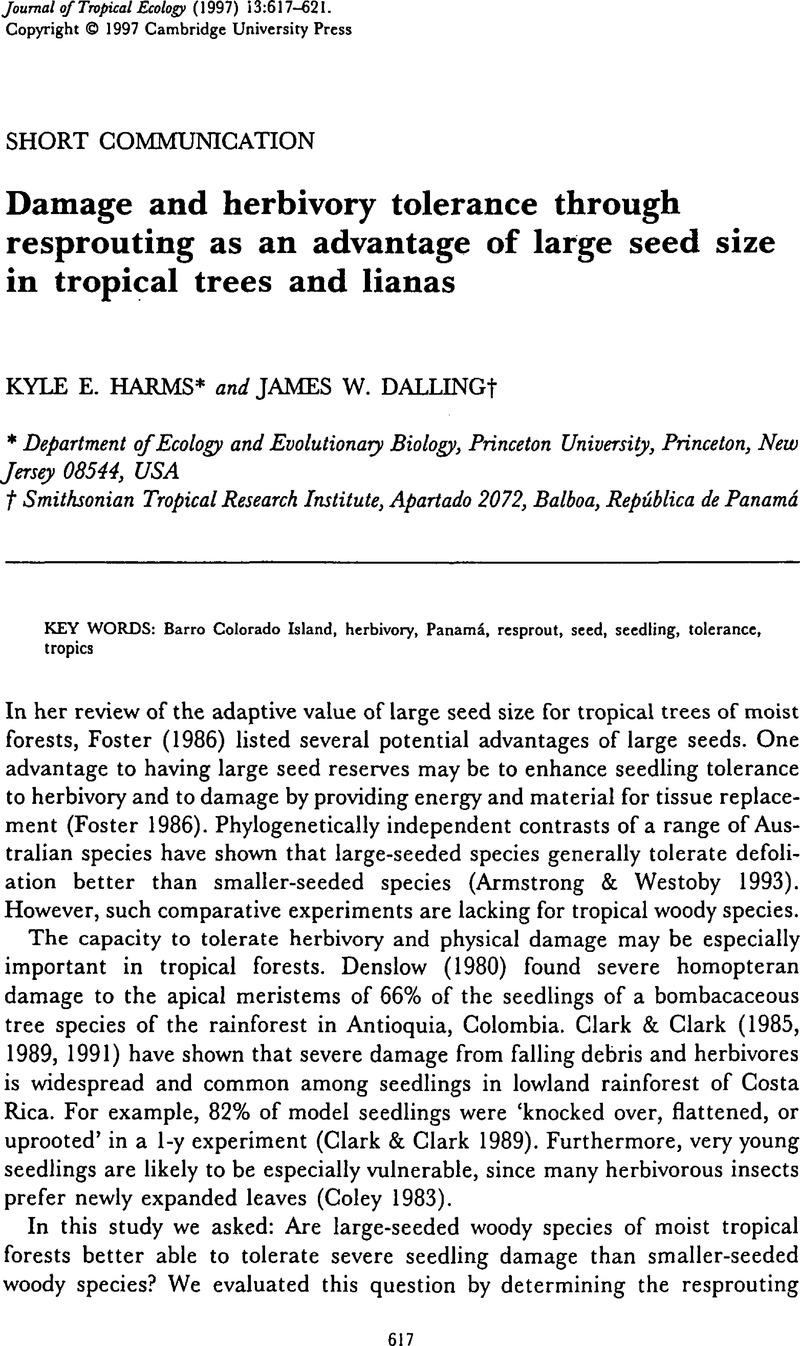Crossref Citations
This article has been cited by the following publications. This list is generated based on data provided by Crossref.
Dalling, J. W.
Harms, Kyle E.
and
Aizprúa, Rafael
1997.
Seed damage tolerance and seedling resprouting ability of Prioria copaifera in Panamá.
Journal of Tropical Ecology,
Vol. 13,
Issue. 4,
p.
481.
Guariguata, Manuel R.
and
A. Pinard, Michelle
1998.
Ecological knowledge of regeneration from seed in neotropical forest trees: Implications for natural forest management.
Forest Ecology and Management,
Vol. 112,
Issue. 1-2,
p.
87.
Dalling, J. W.
Hubbell, Stephen P.
and
Silvera, Katia
1998.
Seed dispersal, seedling establishment and gap partitioning among tropical pioneer trees.
Journal of Ecology,
Vol. 86,
Issue. 4,
p.
674.
Holl, Karen D
and
Quiros-Nietzen, Edgar
1999.
The effect of rabbit herbivory on reforestation of abandoned pasture in southern Costa Rica.
Biological Conservation,
Vol. 87,
Issue. 3,
p.
391.
ICHIE, Tomoaki
NINOMIYA, Ikuo
and
OGINO, Kazuhiko
2000.
Tropics,
Vol. 9,
Issue. 2,
p.
153.
Hoffmann, William A.
2000.
Post-Establishment Seedling Success in the Brazilian Cerrado: A Comparison of Savanna and Forest Species1.
BIOTROPICA,
Vol. 32,
Issue. 1,
p.
62.
Connell, Joseph H.
and
Green, Peter T.
2000.
SEEDLING DYNAMICS OVER THIRTY-TWO YEARS IN A TROPICAL RAIN FOREST TREE.
Ecology,
Vol. 81,
Issue. 2,
p.
568.
Hoffmann, William A.
2000.
Post‐Establishment Seedling Success in the Brazilian Cerrado: A Comparison of Savanna and Forest Species1.
Biotropica,
Vol. 32,
Issue. 1,
p.
62.
LOPEZ, O. R.
2001.
Seed flotation and postflooding germination in tropical terra firme and seasonally flooded forest species.
Functional Ecology,
Vol. 15,
Issue. 6,
p.
763.
Edwards, Will
Gadek, Paul
Weber, Ellen
and
Worboys, Stuart
2001.
Idiosyncratic phenomenon of regeneration from cotyledons in the idiot fruit tree, Idiospermum australiense.
Austral Ecology,
Vol. 26,
Issue. 3,
p.
254.
Takakura, K.
2002.
The specialist seed predator Bruchidius dorsalis (Coleoptera: Bruchidae) plays a crucial role in the seed germination of its host plant, Gleditsia japonica (Leguminosae).
Functional Ecology,
Vol. 16,
Issue. 2,
p.
252.
Westoby, Mark
Falster, Daniel S.
Moles, Angela T.
Vesk, Peter A.
and
Wright, Ian J.
2002.
Plant Ecological Strategies: Some Leading Dimensions of Variation Between Species.
Annual Review of Ecology and Systematics,
Vol. 33,
Issue. 1,
p.
125.
Jackson, Scott M
Fredericksen, Todd S
and
Malcolm, Jay R
2002.
Area disturbed and residual stand damage following logging in a Bolivian tropical forest.
Forest Ecology and Management,
Vol. 166,
Issue. 1-3,
p.
271.
Kitajima, K.
2002.
Do shade‐tolerant tropical tree seedlings depend longer on seed reserves? Functional growth analysis of three Bignoniaceae species.
Functional Ecology,
Vol. 16,
Issue. 4,
p.
433.
Kitajima, Kaoru
2003.
Impact of Cotyledon and Leaf Removal on Seedling Survival in Three Tree Species with Contrasting Cotyledon Functions1.
BIOTROPICA,
Vol. 35,
Issue. 3,
p.
429.
Paz, Horacio
and
MartÍnez-Ramos, Miguel
2003.
SEED MASS AND SEEDLING PERFORMANCE WITHIN EIGHT SPECIES OF PSYCHOTRIA (RUBIACEAE).
Ecology,
Vol. 84,
Issue. 2,
p.
439.
Kitajima, Kaoru
2003.
Impact of Cotyledon and Leaf Removal on Seedling Survival in Three Tree Species with Contrasting Cotyledon Functions1.
Biotropica,
Vol. 35,
Issue. 3,
p.
429.
Paz, Horacio
2003.
Root/Shoot Allocation and Root Architecture in Seedlings: Variation among Forest Sites, Microhabitats, and Ecological Groups1.
Biotropica,
Vol. 35,
Issue. 3,
p.
318.
Paz, Horacio
2003.
Root/Shoot Allocation and Root Architecture in Seedlings: Variation among Forest Sites, Microhabitats, and Ecological Groups1.
BIOTROPICA,
Vol. 35,
Issue. 3,
p.
318.
Jansen, Patrick A.
Bongers, Frans
and
Hemerik, Lia
2004.
SEED MASS AND MAST SEEDING ENHANCE DISPERSAL BY A NEOTROPICAL SCATTER‐HOARDING RODENT.
Ecological Monographs,
Vol. 74,
Issue. 4,
p.
569.





